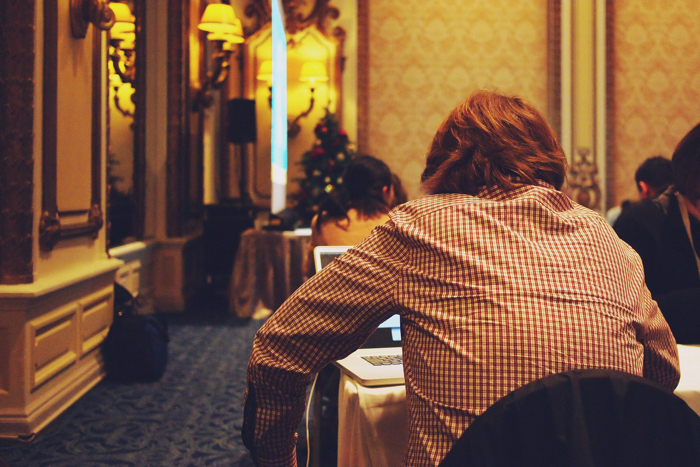A Guide to Creating an Optimal Remote Workspace from Scratch

Working remotely can lead you on a downward spiral of demotivation if your workspace isn’t encouraging, healthy and well-equipped, so that you can do the work that you’ve been hired to do. Critically-acclaimed collaboration tools and excellent skills are far less effective if your workspace is none of these things.
I use the term “workspace” loosely, because we all have different types of workspaces depending on what we do for a living and our individual temperaments. Some of us have more than one workspace, and some of us have a different one everyday (i.e. those that require less equipment and work from cafés and bars).
In order to create a remote workspace that’s right for you, one that keeps you happy and motivated as well as boosts your creativity, you first need to ask yourself these questions:
Looking for your next role? The SitePoint Remote job board helps you find the best remote jobs in tech.
Equipment: What Type of Work Do You Actually Do?

Your equipment largely depends on what you do, which can range from a simple 11” laptop to a much larger 27” desktop (and we’re only talking about computers here!). But that doesn’t mean that some roles are restrictive; quite often we assume that more (or bigger) equipment is better, when in fact, less is usually more.
First, consider what equipment you actually need.
Standing desk? Full desk? Just a table in a café? Minimising (especially Wi-Fi-enabled devices if you’re addicted to checking emails) can certainly improve your productivity, if not enable you to work outside whenever you feel like it. Amazon, or even our very own SitePoint shop has a huge inventory of mobile desks, fold-up tablet stands and so on.
Gadgets like these are more than suitable for use at home, as well, so your remote workspace travels wherever you go.
Ambience: What Makes You Happy, But Not Distracted?

For me it’s working in a café. I don’t have much equipment as a writer but I require a little bit of background noise to function correctly; not music, because the lyrics conflict with my written words, and for others too, it’s hard to read when there’s music.
For creative types on the other hand, music can be a huge motivator. Consider what kind of noise and ambience motivates you to work without distracting you; that can be the live sound of various conversations in a busy co-working space, or the recorded sounds of an ambient noise app like Noisli.
If you need to work at home because you’re required to take conference calls in between work sessions, but working from cafés is definitely your style, Noizio even has “Paris Café” setting!
Green Plants Can Boost Creativity

Plants — yes, that’s right, plants. Plants can boost creativity by up to 50%. Whether you enjoy working for an hour a day in a natural open space, or you keep a few tiny bonsai trees on your at-home desk, either can massively improve your work output. Not only do they clean the air in a room, but brief exposure to the colour green can induce creative and innovative thinking.
Optimizing Temperature Can Boost Productivity
When it’s too hot we become frustrated and restless, but when it’s too cold we feel like we’d rather wrap up in bed. Studies show that the optimal temperature is between 70-73 degrees Fahrenheit (or 21-23 degrees Celsius). It’s amazing how much difference a few degrees can make. Since there’s no thermostat for the wonderful outdoors, this is something you need to consider if you’re working from cafés for example; co-working spaces on the other hand are more likely to have optimized this.
Communication: When/How Do You Collaborate with Your Teammates?

One of the biggest misconceptions about working remotely is that you won’t really have “the space to do more work”. If you work within a team you’ll (usually) have to make even more of an effort to stay connected to your teammates and maintain a culture of accountability (so your boss knows you’re not slacking off).
Your level of independence depends on:
- How often the team’s timezones overlap
- How often you need to collaborate on a task
- How often you need to engage in conference calls
All three of these things should contribute towards your decision as to whether working in cafés and co-working spaces is a suitable idea or not. Does your spot have excellent Wi-Fi? Is it quiet enough? Are you able to carry a headset for optimal sound? If you can’t hold a conversation because of noise and a less-than-optimal Wi-Fi connection, working outdoors is not for you.
Full-Featured, Cross-Platform Messaging Apps
If you work in a team but you don’t necessarily collaborate with it, or you don’t need to hold too many virtual meetings, a core messaging app like Slack or HipChat(both cross-platform) will do you fine.
You can extend Slack/HipChat’s capabilities to integrate with the other apps that your team uses, and there are even options to hold conference calls in case you do need a full-on team meeting.
Conclusion
Here’s my ultimate tip for creating remote workspaces: try everything. It’s a finely-tuned setup and what may work for you one day may not work for you the next. It depends on the tasks for that day, the equipment required, your level of independence (or how often you need to communicate with your team) and your mood.
Need a little inspiration? Check out the unique remote workspaces from the employees at Zapier!
Do you have a workspace that works for you, or against you? Share your experiences with remote working in the comments below!



